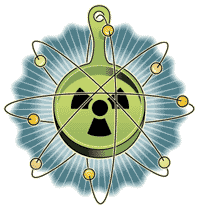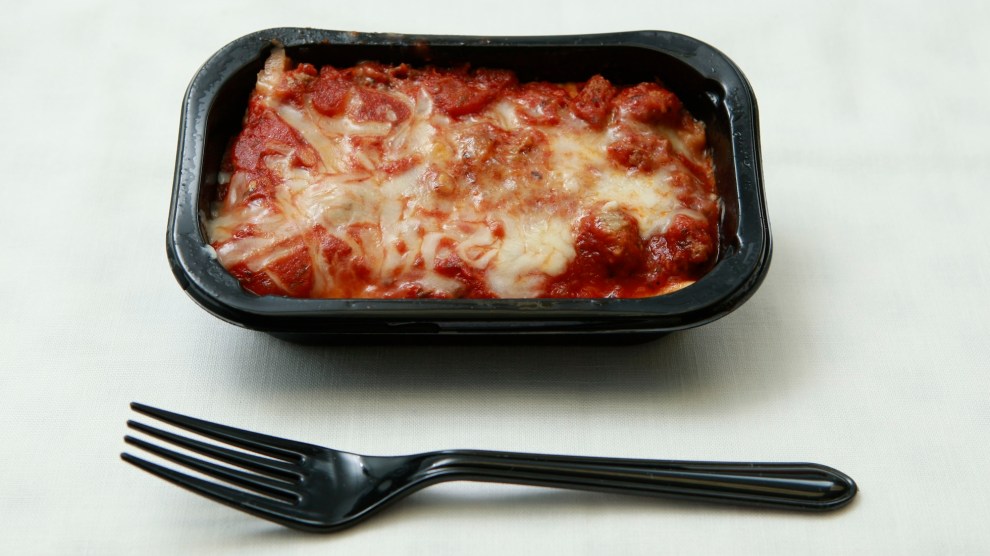
Image: Peter Hoey
From the air, the East Tennessee Technology Park looks like clusters of enormous Wal-Marts, sprawling across 4,700 acres in the rural countryside west of Knoxville. But for decades the Oak Ridge complex had a more ominous name — the K-25 site. Its mission: to produce highly enriched uranium for nuclear weapons.
Today, the facility contains tons of contaminated junk — machinery, metal, concrete, and tools — some of which will remain radioactive for generations. Faced with a massive cleanup, the Department of Energy has come up with an ingenious plan to get rid of the slightly radioactive scrap: “recycle” the metal and sell it for reuse. Both the DOE and the Nuclear Regulatory Commission (NRC) are quietly revising rules that would allow millions of tons of radioactive garbage at the nation’s weapons facilities and nuclear reactors to be converted into consumer products and building materials. Under the plan, the leftover metal could end up in baby strollers, bikes, frying pans, engine blocks, and I-beams.
“This scrap is an asset,” says Val Loiselle, former director of the Association of Radioactive Metal Recyclers. “Until now, we’ve literally been burying our assets.”
Most low-level radioactive materials are currently disposed of in secure, government-licensed landfills. But as former weapons plants are cleaned up and aging reactors are decommissioned, the volume of nuclear junk is expected to soar. The DOE already has 1.6 million tons of slightly radioactive metals at weapons installations across the country, and the NRC expects to have 8.9 million tons of contaminated steel and concrete to dispose of by 2030.
In the past, both the DOE and NRC have recycled such materials on a case-by-case basis. At K-25, for example, approximately 6.6 million pounds of slightly radioactive material left Oak Ridge’s gates before sales were halted in 2000. The material was treated no differently than any other scrap, and nobody made any effort to keep track of where it ended up.
But with the nuclear scrap heap mounting, federal agencies and industry officials want a formalized recycling program in place to speed up the disposal. The plan calls for setting an exposure standard below which irradiated metals would be deemed “safe” and suitable for release. Because radiation levels would be low, the reasoning goes, there would be no need for labels identifying that the materials came from nuclear reactors or weapons facilities — even if they end up in homes, offices, and schools.
If the changes are implemented, they would end a decades-long policy against the intentional release of radioactivity into the general populace. Opponents of the plan say it could jeopardize public health, exposing consumers to materials previously deemed too contaminated to use. “One day it’s hazardous, the next day it’s safe,” says David Ritter, a policy analyst with the consumer advocacy group Public Citizen in Washington, D.C. “They just change the definition.”
Some of the most vocal opponents of the plan are those who would be on the receiving end of the “released” materials. “The DOE and the nuclear community cannot use us as a dumping ground for their waste,” says Thomas Danjczek, president of the Steel Manufacturers Association, which processes 70 million tons of recycled material a year. “We worry about damaging the public perception of steel being a safe material. If this goes through, it would kill our market.”
In the past, such concerns have been enough to block attempts to redefine what constitutes radioactive waste. Since 1980, the NRC has twice proposed rule changes declaring some irradiated material as “below regulatory concern,” meaning there would be no limits on its reuse or disposal. Congress eventually intervened to block the rules.
In 2000, hoping to gain support for its newest recycling plan, the NRC contracted with the National Research Council to convene a panel to review its recommended changes. But in March the panel declined to endorse the wholesale release of radioactive materials, observing that the NRC has “failed to convince any environmental and consumer advocacy groups that the clearance of slightly radioactive solid material can be conducted safely.”
Radioactive recycling efforts at the DOE have also run into sharp criticism. In 1999, a federal judge in Washington ruled that not enough was known about the dangers of releasing radioactive materials at the K-25 site. “The potential for environmental harm is great, especially given the unprecedented amount of hazardous materials which [officials] seek to recycle,” U.S. District Court Judge Gladys Kessler declared.
Despite the widespread opposition from consumer advocates, steel manufacturers, and scientists, federal officials appear determined to proceed with recycling. The reason? Dollars and cents. If decommissioned debris from the nation’s 103 nuclear plants must be buried in secure landfills, costs to the utility industry may hit $12 billion. If the rubble can simply be carted to the nearest landfill or scrap metal broker, the price could be as low as $300 million.
History offers some indication of what can happen when radioactive materials find their way into consumer goods. In the early 1980s, contaminated metal from unknown sources was fabricated into jewelry (wearers developed cancer and lost their fingers) and restaurant table legs (most were detected prior to delivery, but some patrons and employees may have been exposed to radioactive cobalt 60). In 1998, occupants in Taiwanese apartment buildings made with radioactive steel beams began reporting health problems, and a Michigan manufacturer was forced to recall hundreds of La-Z-Boy recliners after learning that the rocker springs contained radioactive metal.
Despite the health risks, global trade in radioactive materials is thriving. The European Union has already set standards allowing the release of materials contaminated with what it calls “trivial” amounts of radiation, and industry trade groups like the Nuclear Energy Institute are pressuring the United States to follow suit. “Consistency with standards set by other nations and international agencies is important,” the NRC declared in a 1999 report, “because materials can be both imported and exported between the U.S. and other countries, and differing standards could create confusion and economic disparities in commerce.” Officials at the Department of Transportation are currently revising rules on radioactive shipments to conform to international guidelines.
But with so much of the current regulatory focus on economics and commerce, consumer advocates worry that a simple fact of physics is being overlooked: Any dose of radiation, no matter how small, increases the risk to public health. And if a host of recycled products ßoods the market, there will be no way to measure the effects of multiple doses.
“When it comes to ionizing radiation, you can’t draw some line and say anything above that line is dangerous and anything below is safe,” says Ritter, the policy analyst with Public Citizen. “You have to ask: What is avoidable, what is preventable?”











